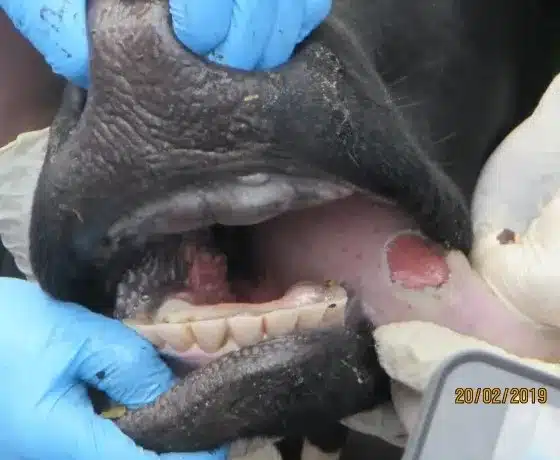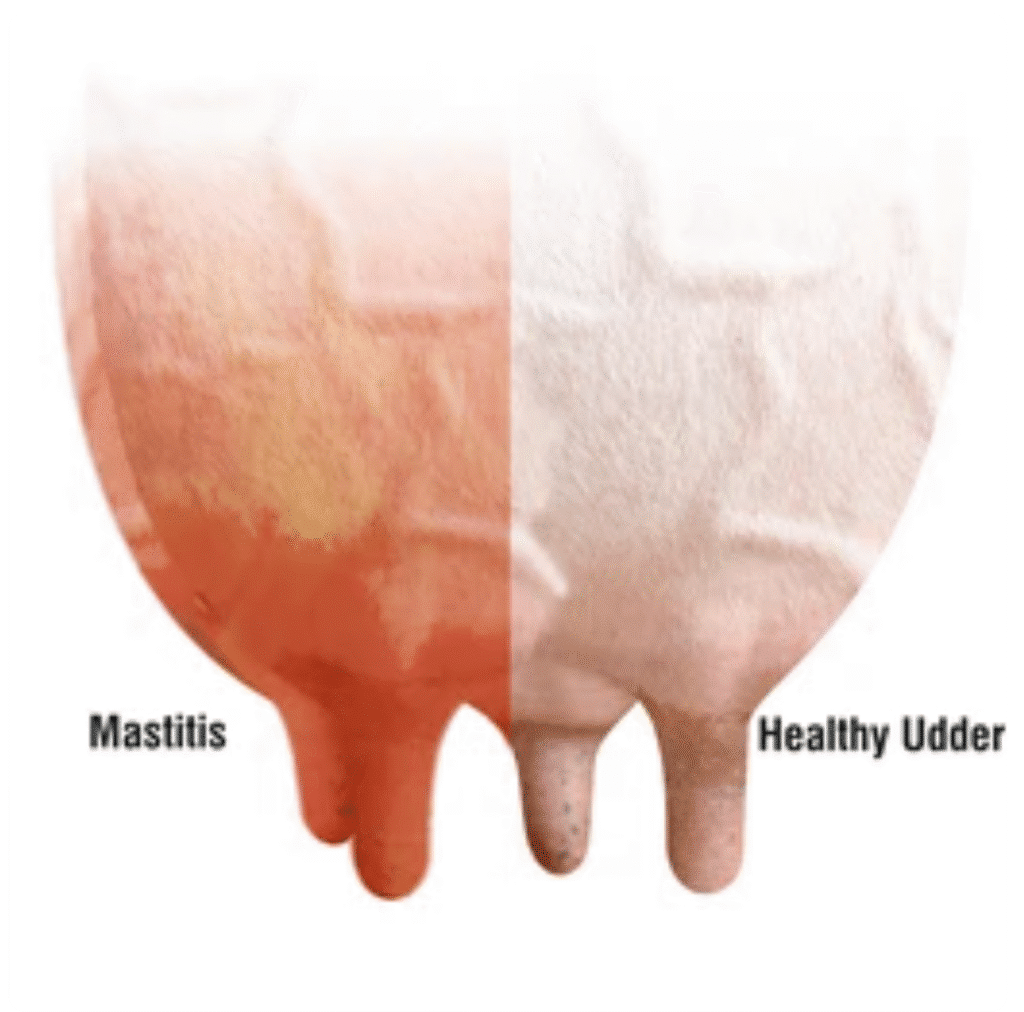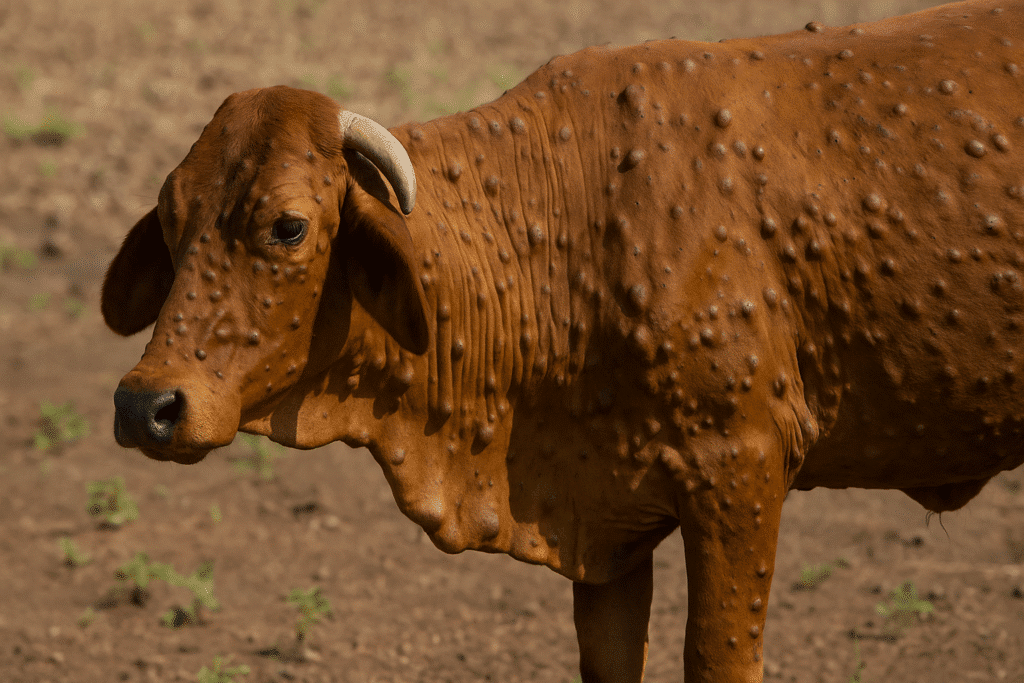Foot-and-mouth disease in cattle is a serious and highly contagious viral disease that affects livestock such as cattle, pigs, sheep, goats, and other animals with split hooves (cloven-hoofed animals). Foot and Mouth disease in cattle spreads quickly and can cause major economic losses, especially in cattle farming and trade. FMD disease in cattle is caused by a virus that mainly affects even-toed animals, both domestic and wild. Infected Cattle develop a high fever that lasts 2 to 6 days. However, this illness in FMD cattle can be longer, ranging from 7 to 10 days. This is followed by the formation of painful blisters (vesicles) in the mouth, on the tongue, lips, and around the hooves. These blisters can burst, leading to sores that make it difficult for animals to eat, walk, or move—often causing lameness.
Foot and mouth disease (FMD) in cattle is a fast-spreading viral infection caused by the foot and mouth disease virus (FMDV), known scientifically as Aphthovirus, from the Picornaviridae family. There are seven different types (serotypes) of this virus: A, O, C, SAT1, SAT2, SAT3, and Asia1. Among them, serotype C has not been reported since 2004, suggesting it may no longer be active. However, the other serotypes still exist in various parts of the world. Each serotype of FMD virus is different, and animals must be vaccinated with a specific vaccine that matches the strain to gain protection. Because of this, controlling foot and mouth disease for cattle can be challenging, especially in areas with limited resources.
Foot and Mouth Disease Short History
Foot and mouth disease for cattle has a long history, with records tracing back to the sixteenth century when it was recognized as a serious threat to livestock. In 1898, scientists Loeffler and Frosch discovered that the illness was caused by a submicroscopic, filterable agent—making the foot and mouth disease virus the first known virus affecting vertebrates, shortly after the discovery of the tobacco mosaic virus in plants. By 1920, guinea pigs were introduced as a model for studying the virus, which later led to the development of cell culture systems.
The complete 3D structure of the foot and mouth disease virus in cattle was described in 1989. The United States first encountered the disease in 1870 and successfully eradicated it by 1929. Over time, FMD became one of the most studied animal diseases, with the World Reference Laboratory for FMD established in Pirbright, UK, conducting global monitoring through serotyping and genotyping of viral strains
Foot and Mouth Disease Symptoms in Cattle
The initial symptoms of foot and mouth disease in cattle’s include fever, excessive salivation, loss of appetite, shivering, lameness, a sudden drop in milk production, reddening of the mouth’s mucous membranes, and early signs of blisters in the mouth or on the feet. Within a short period especially in confined or closely grouped herds additional animals begin to show similar signs, making the spread swift and widespread.
A hallmark of FMD disease in cattle’s is the appearance of painful blisters in various parts of the body. These often develop in the mouth (on the lips, tongue, and gums), between the toes, near the hooves, on the teats, and at common pressure points. Once these blisters rupture, the affected cattle may experience severe lameness, reluctance to move, and difficulty feeding. Although many recover within a week, open lesions can lead to bacterial infections, further complicating healing.
As the FMD virus in cattle progresses, animals may lose weight rapidly and experience long-term reductions in growth and milk production, sometimes up to 80%. In males, swelling of the testicles can occur, affecting the health of dependent calves. Young animals are especially vulnerable, as limited milk availability can hinder survival and development. While recovery is possible, foot and mouth disease in cattle often results in lasting productivity losses and presents a serious threat to herd health and farm economics.
Causes of Foot and Mouth Disease in Cattle
Foot and Mouth Disease (FMD) is a highly contagious viral infection that significantly impacts livestock health and productivity. The disease primarily affects cloven-hoofed animals, with FMD disease in cattle posing a major concern for both small-scale farmers and commercial producers. The causative agent is the Foot and Mouth Disease Virus (FMDV), an RNA virus from the Aphthovirus genus in the Picornaviridae family. Its ability to spread through various biological and environmental channels makes it one of the most challenging livestock diseases to control.
One of the core causes of foot and mouth disease cattle outbreaks is the virus’s persistence in the environment. FMDV can survive in contaminated soil, feed, water sources, and surfaces such as fencing, floors, and troughs. These contaminated areas become long-term reservoirs of infection, putting healthy cattle at risk even in the absence of visibly sick animals.
Another major way the virus spreads is through animals that carry it without showing any signs. Wild animals, stray livestock, or even cattle that recently got better can still spread the virus without anyone knowing. Poor biosecurity and the virus being common in some areas make things worse. Farms without proper quarantine or regular cleaning are at high risk. In these regions, the virus keeps spreading among animals and in the environment, always posing a threat.
Diagnosis of Foot and Mouth Disease (FMD) in Cattle
Quick and accurate diagnosis of Foot and Mouth Disease (FMD) is very important. Finding the disease early helps start control measures right away and stops it from spreading through herds and to other areas.
Clinical Observation and Initial Signs
The first step in diagnosing FMD begins with clinical observation. Cattle infected with the virus often exhibit:
- Fever (typically 40–41°C or 104–106°F)
- Excessive salivation and stringy drool
- Blisters (vesicles) in the mouth, tongue, dental pad, nostrils, teats, and between the hooves
- Lameness, reluctance to move, or lying down due to painful foot lesions
- Loss of appetite and decreased milk production
These symptoms usually appear within 2–14 days after exposure to the virus. It is essential to handle suspected animals with care and isolate them immediately, as the virus can spread rapidly through direct contact, aerosol droplets, or contaminated equipment.
Laboratory Confirmation of FMD Virus
Foot and mouth disease (FMD) in cattle’s is confirmed in the lab using specific samples and tests. The best sample to collect is the skin or fluid from the blisters. At least 1 gram of tissue should be placed in a special solution like phosphate-buffered saline (PBS) or a mix of glycerol and buffer with pH 7.2–7.6. Samples should be kept cold and transported on ice. If there are no visible blisters, oropharyngeal fluid can be collected using a probang cup or swab from the throat. Blood samples may also be tested, but the virus stays in the blood only for a short time. In animals that have recovered but may still carry the virus, repeated sampling from the throat may be needed.
Sample collection tips:
- Best sample: vesicular epithelium or fluid (at least 1 g)
- Use PBS or glycerol-buffer (pH 7.2–7.6) for storage
- Keep samples cold during transport
- Use oropharyngeal swabs if no vesicles are present
- Blood samples are useful only in early infection
- Repeated testing may be needed for carriers
In the lab, real-time RT-PCR is the main test used because it is very sensitive and can detect even small amounts of virus, even in samples that are not well-preserved. Researchers also use antigen ELISA tests to detect the virus and determine its type (serotype). In advanced laboratories, scientists sequence part of the virus’s genetic material to identify the strain. They may also isolate the virus in cell cultures. For quick field testing, lateral flow devices can detect virus antigens on the spot. Serology (antibody testing) is used for confirming infection, checking vaccine effectiveness, and trade certification. However, only antibodies to nonstructural proteins (made during real infection) can show if an animal was infected, since vaccines produce antibodies to structural proteins too. These tests may miss infection in vaccinated animals if virus replication is very low.
Lab tests used:
- RT-PCR: Very accurate, detects virus RNA
- Antigen ELISA: Finds virus type
- Sequencing: Identifies strain and lineage
- Virus isolation: Confirms live virus
- Lateral flow tests: Quick, on-site results
- Serology:
- Nonstructural protein antibodies = real infection
- May miss mild infections in vaccinated animals
Treatment of Foot and Mouth Disease (FMD) in Cattle
Once Foot and Mouth Disease in cattle’s is identified within a herd, treatment and control should begin immediately. Since the disease is viral, there is no specific cure for the virus itself. Still, supportive care, symptom management, and infection control can help the affected cattle recover and prevent the spread to other animals.
The first step in foot and mouth disease treatment is to isolate infected animals to avoid contact with healthy ones. Use separate feeding and watering equipment, and disinfect areas and equipment regularly. During the outbreak, always care for healthy animals first and infected ones afterward to minimize the risk of spreading the virus within the farm.
Supportive Treatment for FMD in Cattle
Supportive care is the most important aspect of FMD management. This includes managing fever, reducing pain, treating wounds, maintaining hydration, and preventing secondary infections.
Fever and Pain Management
Non-steroidal anti-inflammatory drugs (NSAIDs) are used to control fever, inflammation, and pain caused by the mouth and hoof lesions seen in foot and mouth disease cattle.
Common NSAIDs Used:
- Flunixin meglumine
- Meloxicam
These medications should be administered based on the weight and condition of the animal. Treatment usually continues for 3–5 days. These drugs help reduce discomfort and improve the animal’s appetite and mobility.
Wound Cleaning and Care
Painful blisters and ulcers appear in the mouth, between the hooves, and on the teats. Proper cleaning and protection of these wounds are essential to prevent bacterial infection.
How to Clean Wounds:
- Use a diluted solution of povidone-iodine or potassium permanganate (KMnO₄).
- Clean the affected areas gently twice a day.
- Apply antiseptic spray, zinc oxide cream, or healing ointments to promote tissue repair and prevent flies.
Antibiotics for Foot and Mouth Disease
Although FMD is viral, open sores are highly prone to bacterial infection. In such cases, antibiotics for foot and mouth disease may be prescribed to prevent or treat complications like foot rot, mastitis, or pneumonia.
|
Antibiotic Name |
Route | Common Brands (varies) |
| Oxytetracycline | IM/IV | Terramycin, Alamycin |
| Penicillin-Streptomycin | IM | Pen & Strep, Combi-Pen |
| Amoxicillin | IM/IV | Polyflex, Ampicare |
Common Antibiotics Used for FMD:
These antibiotics are given by injection for 3–5 days depending on the severity of infection. Always follow veterinary advice and dosage instructions strictly.
Immune and Nutritional Support
Boosting the animal’s immune system helps fight the virus and recover faster.
Recommended Supplements:
- Vitamin A, D, and E
- Zinc and Selenium
- Electrolyte solutions
These can be administered orally or through injection, and help in wound healing, restoring energy levels, and fighting infection.
Vaccination Against Foot and Mouth Disease
Vaccination is not a cure for infected cattle, but it is critical for preventing further infections in healthy animals and controlling the spread of the virus on the farm. It’s also a key strategy in areas where foot and mouth disease cattle outbreaks are frequent.
Commonly Used FMD Vaccines:
| Vaccine Name | Type | Usage |
| Raksha-Ovac (Indian Immunologicals) | Multivalent vaccine | Used in endemic and emergency cases |
| Footvax (MSD Animal Health) | Inactivated vaccine | Effective in regions with outbreaks |
| MVP-FMD | Multivalent | Covers common serotypes (O, A, Asia-1) |
Healthy animals should be vaccinated as soon as possible during an outbreak. Booster doses may be required as per local veterinary guidelines.
Incubation Period of Foot and Mouth Disease
The incubation period of Foot and Mouth Disease, the time between exposure and the appearance of symptoms typically ranges from 2 to 14 days, depending on the virus strain and the animal’s immune status. During this period, infected animals may already spread the virus even if symptoms are not yet visible, making early isolation and biosecurity crucial for herd protection.
Foot and Mouth Disease Transmission in Cattle
As a veterinarian working closely with cattle herds, it’s important to understand that Foot and Mouth Disease (FMD) spreads extremely fast, primarily through direct contact between infected and healthy cattle. When an infected animal coughs, drools, or sheds virus in feces or milk, nearby cattle can easily pick it up through their skin, mouth, or respiratory system.
Beyond direct contact, FMD can also spread through the air, especially in humid or enclosed environments. The virus can travel short distances via aerosols, which makes it highly dangerous in high density herds. Additionally, contaminated feed, water, or even the hands and clothing of farm workers can serve as indirect carriers of the virus, unknowingly passing it from one animal to another.
What many farmers overlook is that shared objects like tools, footwear, vehicles, or feeding troughs can hold and transmit the virus if not properly disinfected. Even a healthy looking animal or human can introduce the virus if they’ve been in contact with infected herds. This is why strict biosecurity, routine disinfection, and movement control are critical to stopping the spread of FMD in cattle farms.
Foot and Mouth Disease Prevention in Cattle
Preventing Foot and Mouth Disease in cattle begins with strict biosecurity and hygiene measures at the farm level. Since the virus can spread through direct animal contact, contaminated surfaces, and even humans, limiting farm access to essential personnel and ensuring proper disinfection of equipment, vehicles, and footwear is critical. Newly purchased or returning animals should be quarantined for at least 2 weeks before being introduced to the main herd to detect any hidden infections during the incubation period.
Routine cleaning and disinfection of cattle housing, feeding areas, and handling tools significantly reduce the chance of viral survival in the environment. Farmers should establish protocols for handling waste, dead stock, and manure, as improper disposal can become a major source of contamination. During high-risk periods or in regions with ongoing outbreaks, farms should suspend animal movement, restrict visitor access, and reinforce staff training on recognizing early symptoms of FMD.
Vaccination is an important way to prevent the disease in areas where it often occurs. Antibiotics don’t kill the virus, but they can help treat other infections that happen because of it. Still, the main goal should be to stop the virus from entering and spreading. Regular health monitoring, immediate reporting of unusual symptoms, and maintaining updated vaccination records are essential. Effective prevention of FMD requires a proactive, disciplined approach to herd health, as a single oversight can trigger widespread transmission and severe economic loss.
Environmental Disinfection and Farm Biosecurity
To stop the virus from spreading, thorough cleaning and disinfection of all farm areas and tools is essential.
Disinfectants Used:
- 4% Sodium Carbonate (washing soda)
- 0.2% Citric Acid Solution
- Bleaching Powder (calcium hypochlorite)
Disinfect sheds, feeding equipment, milking areas, and footwear daily. Burn or deeply bury contaminated bedding and feed.
Field Protocol for Vets and Farmers
Veterinarians and farm personnel should follow these key diagnostic steps:
- Isolate suspected animals immediately.
- Record clinical signs and the progression of symptoms.
- Notify veterinary authorities if FMD is suspected.
- Collect samples safely while wearing protective gear.
- Send samples to an approved FMD reference laboratory.
- Implement movement restrictions and biosecurity on the farm.
Conclusion of foot and mouth disease
In conclusion, foot and mouth disease is a highly contagious viral infection that poses a major threat to cattle health and livestock productivity. It spreads quickly rapidly through direct contact, contaminated materials, or the environment. While there is no specific cure, early detection, vaccination, and strict biosecurity measures are essential to limit outbreaks and reduce impact. Supportive care can aid recovery and prevent complications. Effective control depends on cooperation between farmers, veterinarians, and authorities to protect animal health and sustain the livestock industry.
FAQs of Foot And Mouth Disease in Cattle
What is foot and mouth disease in cattle?
Foot and mouth disease in cattle is a highly contagious viral infection that causes fever and painful blisters on the mouth, tongue, lips, and hooves. It affects cloven-hoofed animals and leads to lameness, reduced milk production, and severe economic losses in livestock farming.
How does foot and mouth disease spread in cattle?
Foot and mouth disease spreads in cattle mainly through direct contact with infected animals via saliva, mucus, or contaminated secretions. It can also spread indirectly through contaminated feed, water, equipment, clothing, and aerosols in crowded or enclosed environments.
How to prevent foot and mouth disease in cattle?
To prevent foot and mouth disease in cattle, maintain strict biosecurity by limiting farm access and disinfecting equipment and footwear regularly. Quarantine new or returning animals for at least two weeks and ensure timely vaccination. Regular monitoring and quick reporting of symptoms are also essential to control outbreaks.
How to treat foot and mouth disease in cattle?
Foot and mouth disease in cattle has no direct cure, so treatment involves isolating infected animals and providing supportive care. Pain and fever are managed with NSAIDs like Flunixin or Meloxicam, while wounds are cleaned with antiseptics to prevent infection. Antibiotics such as Oxytetracycline or Penicillin-Streptomycin may be used for secondary bacterial infections. Nutritional supplements like Vitamins A, D, E, Zinc, and electrolytes aid recovery. Vaccines like Raksha-Ovac, Footvax, and MVP-FMD help prevent future outbreaks.
What causes foot and mouth disease in cattle?
Foot and mouth disease in cattle is caused by the Foot and Mouth Disease Virus (FMDV), an RNA virus from the Aphthovirus genus in the Picornaviridae family. It mainly affects cloven-hoofed animals and spreads rapidly through saliva, secretions, contaminated feed, water, equipment, and even aerosols. The virus can survive in the environment for long periods, making it highly infectious. Asymptomatic carriers, including wild animals and recovered cattle, can also transmit the disease.
How to control foot and mouth disease in cattle?
To control foot and mouth disease in cattle, promptly isolate infected animals and enforce strict biosecurity measures such as disinfecting equipment, housing, and restricting farm access. Quarantine new or returning animals for at least 2 weeks. Regular vaccination with region-specific FMD vaccines (like Raksha-Ovac or Footvax) is essential. Early detection, reporting, and supportive care help limit the spread and impact of the disease.
How to cure foot and mouth disease in cattle?
Foot and mouth disease in cattle has no direct cure, as a virus causes it. Treatment focuses on supportive care—using NSAIDs like Flunixin or Meloxicam to reduce pain and fever, cleaning wounds with antiseptics, and giving antibiotics to prevent secondary infections. Nutritional supplements like Vitamins A, D, E, Zinc, and electrolytes support recovery. Prompt isolation and veterinary guidance are essential for effective management.
What medication is used for FMD?
Medications used for Foot and Mouth Disease (FMD) in cattle include NSAIDs like Flunixin meglumine and Meloxicam to reduce pain and fever, and antibiotics like Oxytetracycline, Penicillin-Streptomycin, or Amoxicillin to treat secondary bacterial infections. Antiseptics such as povidone-iodine or potassium permanganate are used for wound cleaning. Nutritional supplements (Vitamins A, D, E, Zinc, electrolytes) support healing and immunity.
Is there a vaccine for foot-and-mouth disease in cattle?
Yes, vaccines are available for foot-and-mouth disease in cattle and are crucial for prevention, especially in endemic areas. Common vaccines include Raksha-Ovac, Footvax, and MVP-FMD, which target multiple FMD virus serotypes. Vaccination helps build immunity and control outbreaks. Booster doses are often required based on regional veterinary guidelines.
What are the symptoms of foot-and-mouth disease?
Symptoms of foot-and-mouth disease in cattle include high fever, excessive drooling, loss of appetite, and lameness. Painful blisters appear in the mouth, on the tongue, lips, and between the hooves. These can rupture into sores, making it hard for animals to eat or walk. There may also be a sudden drop in milk production.



